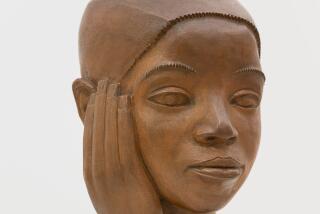Oriented East
Asiana has taken root at the Carnegie Art Museum in Oxnard, if in peripheral ways.
Itâs not really surprising to find Eastern orientation in the art of Elisse Pogofsky-Harris, the Ventura County-based artist gaining wider art-world recognition, and the late Theodore N. Lukits. The lure and influence of Asian themes and aesthetics have long played a role in western art history and creativity, especially this century.
Meanwhile, a new, timely show of local Chinese brush-painting has landed in the downstairs gallery devoted to âMasters in Our Midst.â Although this show has the purest link to the Asian culture it draws on, between the three shows, Asiana is the order of the day.
Lukits (1897-1992), a versatile artist whose work included landscapes, celebrity portraits and the exotic impressionist concoctions seen here, was featured at the Carnegie Art Museum in 1991 with a landscape exhibition. With the current show, titled âAn American Orientalist,â Lukitsâ work conveys a very different personal vision.
In âPeking Operaâ and âCold Command,â we can see the Asian connection clearly in dramatic, almost over-the-top portraits of the thickly ornamented figure of Japanese actor Kamiyana. These are paintings, iridescent of palette and moody of lighting, that brush up against the extreme of being florid kitsch.
Elsewhere in the show, Lukits shows introspective still-life paintings, reflecting on Asian artifacts and a sense of repose. âIncense and Guanyinâ is a still-life study basking in orange light.
Perhaps the melodramatic effects can be traced to a combination of instincts and show biz. His âSelf-Portrait at Twenty,â from 1918, a muted, hazy graphite drawing, finds the artist looking like a self-defined sage in the fog, and the sage kept going west.
Born in Transylvania, Lukits was based in Chicago when silent film siren Theda Bara, whom he had painted, urged him to come to Hollywood, where he proffered his portraiture skills.
We can sense how the hedonistic Tinseltown atmosphere mixed with his Asian leanings. âCarnivalâ finds a nude in a fancy headdress and ruby lipstick in a sensuous pose, warmed by lantern light. By contrast, âIncenseâ demonstrates a subtler use of exaggerated color, pushing toward the French connection of Postimpressionists such as Bonnard.
From a different perspective entirely, the show also includes a couple of Lukitsâ landscape paintings, pointing to the variety of his output. âThrone of the Mountain Gods,â with his snow-capped mountain peak in celestial light, is in stark contrast to the theatricality of his other paintings on display.
The rest of the downstairs gallery, and continuing upstairs, is devoted to Pogofsky-Harrisâ âPaintings of an Inner Life.â The show is a fairly substantial progress report on her series of works based on âimagery of the Old Testament, art history, and indigenous America,â to quote her statement, with asides in Baroque painting notions, particularly as relates to her depiction of furling fabric and her own brand of surrealism.
Not incidentally, she also alludes to Japanese culture and theater in paintings that often blend, as recurring motifs, the presence of wolves, moons and kimonos that seem to float in an irrational, void-like space, free of human intervention. Figures do appear occasionally, as in âThe Infant Moses,â in which a babe is found in the rushes, watched over by a prescient wolf, wise mediator to the spirit world.
Other times, figures might be translucent, apparitions or fools (âThe Cardboard Kingâ). In âLooking for Myself,â an otherwise invisible woman in a kimono catches sight of her face in a hand-held mirror.
These are paintings that, as a series, depict the artistâs personal, exploratory world, played out as if in the depthless space of a dream or a surreal stage set.
DETAILS: Theodore N. Lukits, âAn American Orientalist,â and Elisse Pogofsky-Harris, âPaintings of an Inner Life,â through Feb. 21 at the Carnegie Art Museum, 424 South C St., in Oxnard. Gallery hours: 10 a.m.-5 p.m., Thurs.-Sat.; 1-5 p.m., Sun.; 385-8157.
*
* Josef Woodard, who writes about art and music, can be reached by e-mail at [email protected]
More to Read
The biggest entertainment stories
Get our big stories about Hollywood, film, television, music, arts, culture and more right in your inbox as soon as they publish.
You may occasionally receive promotional content from the Los Angeles Times.










